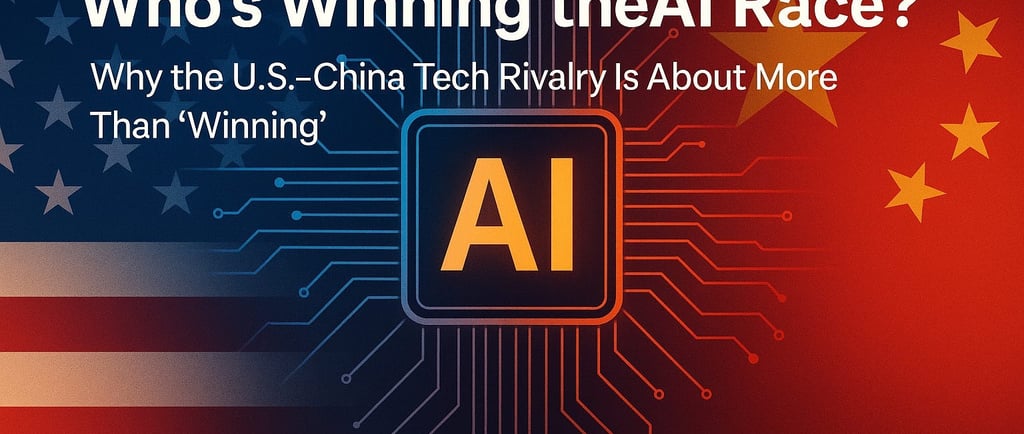Beyond “Who’s Winning” the AI Race?
What the U.S.–China Rivalry Is Also About
Dr. Tarek Cherkaoui
11/11/20253 min read


Over the past few years, the global conversation around artificial intelligence has settled into a familiar storyline: China vs. the United States in a high-stakes technological race.
Reports such as MIT Technology Review’s latest State of AI analysis amplify this frame, suggesting that China is accelerating in compute, data infrastructure, and state-backed industrial coordination at a pace the U.S. struggles to match.
But this rivalry narrative—though grounded in real competition—also serves political and cultural functions that are often overlooked.
1. The “Race” Frame isn’t Neutral—It’s Culturally Engineered
The U.S. media ecosystem has always been receptive to rivalry.
U.S. public opinion has historically been most responsive to meta-narratives framed as epic contests against an external foe—stories that mobilize the public and structure national identity.
The Space Race only gained mass cultural traction when cast as a duel with the Soviets.
The Cold War was narrated as a perpetual standoff with “relentless enemies,” long after the USSR had entered economic decline.
Even today, political messaging polls better when it emphasizes rivalry rather than cooperation.
This pattern is not incidental—it is structural.
American political culture has long used the language of competition to mobilize public support, secure funding, and justify exceptional measures.
And now, AI has been drafted into the same rhetorical tradition.
2. The Rivalry Narrative Makes Surveillance Palatable
Framing AI development as a race against China does more than mobilize patriotism.
It makes certain controversial domestic policies more palatable, even desirable.
When the public is told that:
“China might surpass us,”
“Beijing is building ultra-surveillance states,”
“We must catch up or lose the century,”
…then suddenly, intrusive AI systems no longer look like threats—they appear as necessities.
This is how surveillance capitalism gets legitimized.
Companies like Palantir—notorious for pushing pre-crime models (“predictive policing”) and data-fusion systems—have long struggled to justify their ambitions on civil liberties grounds.
But wrap the same technologies in a narrative of geopolitical survival, and the politics shift entirely.
As investigative reporting has shown, including the Tiberius “public health panopticon” exposé, external threats help soften resistance to:
mass data collection
algorithmic monitoring
social-sorting systems
predictive threat scoring
corporate-state data fusion
militarized AI infrastructure
In other words: the China narrative enables the blue pill of all-out domestic surveillance. This is how surveillance capitalism finds its patriotic disguise.
The public swallows the blue pill not because it is persuaded by the technology, but because it is persuaded by the fear.
3. What the New AI Indicators Actually Show
Beyond the politics, what do the latest AI signals reveal?
China is surging in…
Compute scale, especially through hyperscale data centers and state-backed cloud providers.
Chip self-sufficiency, building out domestic GPU alternatives at accelerated speed.
Mass-deployment capability, integrating AI into factories, logistics, governance, and everyday life faster than Western states.
AI industrial policy, where state coordination aligns compute, talent, and strategic sectors.
The U.S. still leads in…
Foundation model innovation (OpenAI, Anthropic, Google DeepMind).
Frontier-scale research talent and academic ecosystems.
Private-sector capital, with Silicon Valley outspending the rest of the world combined.
Cutting-edge chip design via NVIDIA, AMD, and emerging startups.
But the gap is narrowing where it matters most:
deployment, speed of adoption, and national industrial alignment.
4. The Real Contest Isn’t a Race—it’s a Systemic Divergence
Seeing the story solely as a sprint between rivals obscures what’s actually happening.
The deeper dynamic is this:
The U.S. relies on private companies and market incentives.
China relies on state-directed industrial orchestration.
And both systems have strengths—and vulnerabilities.
The race metaphor is clean but misleading; the reality is a contest between two incompatible governance models, each shaping AI’s future in profoundly different ways.
5. Why the “Race” Framing Will Intensify—Not Fade
Expect Washington to double down on the competition narrative, not abandon it.
Why?
Because it:
mobilizes funding
diffuses resistance to surveillance
unifies polarized political factions
justifies securitization of tech
normalizes intrusions on privacy
positions tech regulation as national defense
Fear has always been a powerful policymaking tool.
In this sense, the “China is winning AI” discourse is not merely analytical—it is also performative.
6. What’s Really at Stake: The Shape of Society Itself
The critical question is no longer “Who will win the AI race?”
It is:
What kind of societies will emerge from it?
Will the U.S. drift further into total surveillance capitalism under the guise of strategic necessity?
Will China deepen its centralized algorithmic governance?
Or will both systems converge toward a model where data power trumps democratic accountability?
The danger is that we become so fixated on the racetrack that we forget to ask where it leads.